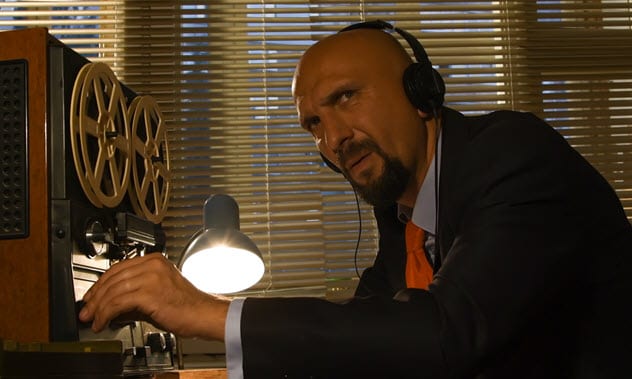 Weird Stuff
Weird Stuff  Weird Stuff
Weird Stuff  Our World
Our World 10 Ways Your Christmas Tree Is More Lit Than You Think
 Movies and TV
Movies and TV The 10 Coolest Stars to Set Sail on The Love Boat
 History
History 10 Things You Didn’t Know About the American National Anthem
 Technology
Technology Top 10 Everyday Tech Buzzwords That Hide a Darker Past
 Humans
Humans 10 Everyday Human Behaviors That Are Actually Survival Instincts
 Animals
Animals 10 Animals That Humiliated and Harmed Historical Leaders
 History
History 10 Most Influential Protests in Modern History
 Creepy
Creepy 10 More Representations of Death from Myth, Legend, and Folktale
 Technology
Technology 10 Scientific Breakthroughs of 2025 That’ll Change Everything
 Weird Stuff
Weird Stuff Ten Bizarre Facts About The Doge Meme
 Our World
Our World 10 Ways Your Christmas Tree Is More Lit Than You Think
 Movies and TV
Movies and TV The 10 Coolest Stars to Set Sail on The Love Boat
Who's Behind Listverse?

Jamie Frater
Head Editor
Jamie founded Listverse due to an insatiable desire to share fascinating, obscure, and bizarre facts. He has been a guest speaker on numerous national radio and television stations and is a five time published author.
More About Us History
History 10 Things You Didn’t Know About the American National Anthem
 Technology
Technology Top 10 Everyday Tech Buzzwords That Hide a Darker Past
 Humans
Humans 10 Everyday Human Behaviors That Are Actually Survival Instincts
 Animals
Animals 10 Animals That Humiliated and Harmed Historical Leaders
 History
History 10 Most Influential Protests in Modern History
 Creepy
Creepy 10 More Representations of Death from Myth, Legend, and Folktale
 Technology
Technology 10 Scientific Breakthroughs of 2025 That’ll Change Everything
Top 10 Chilling Revelations About The Stasi Of East Germany
When we think of the East side of the Cold War, many of us likely imagine KGB officers and discreet agents working out of Moscow. However, while often overlooked by comparison, the Stasi of East Germany (officially the State Security Service of the German Democratic Republic) was without a doubt one of the most brutal secret police agencies in recent history.
From imprisoning political opponents and closely watching every citizen of East Germany to sending “sleeper” agents to live secret lives in various places in the West, the Stasi remains an organization of deep interest to those who study such repressive groups.
Here are 10 things we learned about the Stasi’s activities after the fall of the Berlin Wall and the end of the Cold War. These revelations show just how brutal and harsh an organization it really was. The Stasi was certainly on a par with equivalent agencies working out of Moscow.
10 Unconventional Methods For Successfully Fighting Crime
10 They Were Part Of One Of The Most Repressive Regimes In History

Without a doubt, the Stasi was a repressive secret police agency. They monitored each of their nation’s citizens closely and constantly. They also took decisive action against anyone who went against the accepted ideology. This even necessitated men keeping their hair a certain length. In some cases, people had to wear government-approved clothing.[1]
What’s more, the Stasi was far from discreet about its actions. They often made it crystal clear that they were watching every citizen, especially the ones who had proven themselves to be “enemies” of the communist state.
The Stasi often used wiretaps and steamed open personal mail. In some cases, they drilled holes into the rooms of their citizens to spy directly on them.
Even more chilling for those living under the East German regime, it is thought that the Stasi had around 200,000 informants on their books. Each was willing—or forced—to keep close tabs on his neighbors and even his family.
9 The Stasi Files Conspiracy

At this point, it is probably worth examining how we gained knowledge about the Stasi. This is largely due to their secret files.
Following the fall of the Berlin Wall in 1989, high-ranking Stasi agents issued orders to destroy the mountain of paperwork at their headquarters. These files contained multiple things previously withheld from the public arena—including the names of informants, details of secret trials, and the Stasi’s dealings with the West.[2]
The paper shredding occurred almost immediately. Although around 45 million pages were shredded, activists managed to storm the headquarters before all the files were destroyed. They discovered 600 million pieces of paper in over 15,000 bags. Many of the documents had been torn by hand to destroy as much as possible.
Initially, there was discussion of what to do with the files. However, two years after Germany reunified, it was decided that a special task force would be set up. Their job was to piece together the files, page by page, in order to make the revelations public. For as much as we now know of the Stasi’s activities, it is likely that a considerable amount was lost and will likely remain secret.
8 The Arrests Of Political Opponents

The Stasi especially kept close tabs on political opponents of the East German government. Although many people were arrested and imprisoned, most were interrogated and confined at Hohenschonhausen prison. As we might imagine, conditions were far from luxurious.
Decades later, one former political prisoner recounted how he had been locked in a “small cell” with small windows. These windows “only told you whether it was light or dark outside.” He regularly underwent brutal interrogations designed to mentally weaken him. Like all such prisoners, he was also forced to wear an “ill-fitting blue tracksuit” to further demoralize him.[3]
All this was designed to mentally exhaust the political prisoners so that they would sign confessions. Most often, they were unaware of the charges of which they were accused and only found out on the day of their sentencing.
7 The Plan To ‘Rebrand’ The Stasi

As the 1980s wore on, it became clearer that the communist experiment was failing. In response, the East German authorities began to look at ways to “rebrand” the Ministry for State Security. They opted to become the Office for National Security.
In reality, this was a last attempt to hand the power of a unified Germany to the Stasi under another name. Legislation was even passed to allow this at roughly the same time that Stasi agents were destroying the files of their activities.[4]
However, there was a huge public outcry at the potential move. Combined with the discovery of the destroyed files, this led to the move being blocked. Soon after, the Stasi was broken up.
It is an intriguing thought as to what might have happened if the attempted rebranding had succeeded. Perhaps we only need to look at the decades that have followed the breakup of the Soviet Union. To some, Russia is still a nation being led by the same dictatorship that ruled during the Cold War.
6 They Helped To Train Castro’s Cuban Communists

Although we might expect a kinship between two communist nations such as East Germany and Cuba, it still came as a shock when records revealed a much deeper relationship. It came to light that there was a more intricate connection between the Stasi and its Cuban equivalent, the Ministry of the Interior (MININT).
The discovery was made by a Cuban exile and one-time prisoner of the Stasi. He found that the Stasi had trained Cuban security officers to act with their population in the same way that the East German authorities did. This Cuban exile stated that MININT’s activities were “almost a copy” of the Stasi’s own brutal methods.[5]
Much of this export of ideas took place during the 1970s and ’80s. It involved activities such as using LSD with interrogations, bugging the hotel rooms of tourists, and other security and spying methods. The Stasi also exported hardware and computers to make keeping tabs on Cuban citizens easier.
10 Real Honeypot Operations That Played Out Like Spy Thrillers
5 They Had ‘Sleeper’ Agents In The West For Years

We now know of Cold War activities on both sides of the divide. Perhaps it won’t come as a surprise to discover that the Stasi had “sleeper” agents planted in various places in the West. For all intents and purposes, these agents led normal Western lives and shared in the respective ideology.[6]
They reported all the activities occurring in the West. In some cases, they even influenced these events. Many worked their way up to important positions in government or industry.
Perhaps the best example is the case of Gunter Guillaume. He managed to become the secretary of Willy Brandt, the West German chancellor.
Guillaume regularly reported to Stasi headquarters about Brandt’s activities. Guillaume also told of other goings-on inside the West German government. When he was discovered to be a Stasi agent, it led to Brandt’s public downfall.
4 The Disinformation About HIV/AIDS

Today, it is well established that disinformation is purposely released to the general public. This is often done by certain governments to influence public thinking.
Much the same was true with the Stasi when they had power. Perhaps one of the most outrageous claims came during the initial outbreak of the HIV/AIDS pandemic in the early 1980s.[7]
The mission—known as Operation INFEKTION—even involved the KGB. Aided by the Stasi, the KGB was the chief driver behind the propaganda. According to the main notion of this fake news, HIV/AIDS was created by the United States government as a biological weapon to target certain parts of the population. The creation supposedly took place at Fort Detrick in Maryland.
Although the claims were completely untrue, many millions of people—both in the East and the West—took them as fact. What’s more, these conspiracies persist in some circles today.
3 They Planned To Assist The Communists In North Vietnam

In 1972, when direct US involvement was nearing its end in the Vietnam War, it was revealed that the Stasi had been looking at ways to actively assist the North Vietnamese communists against the United States. Most of this support was to be intelligence training for the North Vietnamese troops. In reality, contact had been taking place between North Vietnam and East Germany since the late 1950s.[8]
The plans were never fully realized. However, the Stasi managed to import intelligence procedures similar to the North Vietnamese mindset. In reality, the Vietnam War was a wider conflict of ideologies. Other communist nations also offered discreet support to the North Vietnamese communist regime.
2 The Sandoz Chemical Spill Conspiracy

Without a doubt, one of the most intriguing revelations about the Stasi’s activities are the claims of their involvement in the Sandoz chemical spill of 1986. Supposedly, this was an attempt to take the world’s attention away from the recent Chernobyl disaster. The claims surfaced shortly after the fall of the Berlin Wall during a German television documentary.[9]
It was stated that the Stasi was behind several “chemical accidents” along the River Rhine. A fire at the Sandoz factory got the most attention. The cause of the fire has still not been established.
The warehouse contained over 1,300 tons of agrochemical products when it ignited. The fire was the cause of huge environmental damage in the months that followed.
There is still debate as to whether the claims are accurate. The television program makers stated that their source was a former CIA agent.
1 They Made Active Attempts To Turn Western Nations Against Each Other

We have already mentioned how the Stasi was involved in disinformation missions regarding the HIV/AIDS outbreak. However, the organization was also active in attempts to turn Western nations against one another.
This was particularly true with the United States. Among Stasi agents, the relevant unit was known as Division X. Its only purpose was to provide information for smear campaigns. This could be photographs, state secrets, and even recordings of conversations.
Perhaps the best example occurred in 1975. Stasi agents secretly recorded talks between Helmut Kohl and Kurt Biedenkopf, two high-ranking West German politicians. The Stasi “leaked” the recording to the media while claiming that it had been made by US agents. It looked like the United States was secretly spying on allied nations.
Remarkably, West German citizens believed that the recording had been made by US intelligence. In part, this was due to increasing distrust of the United States throughout Europe at the time. It is arguably one of the most successful Stasi propaganda missions.[10]
10 US Government Employees Who Defected To The Eastern Bloc
About The Author: Marcus Lowth—writer at Me Time For The Mind—https://www.metimeforthemind.com/
Me Time For The Mind on Facebook—https://www.facebook.com/MeTimeForTheMind/








